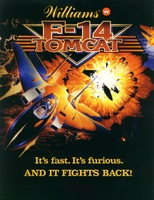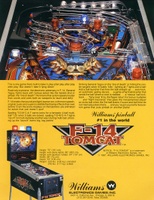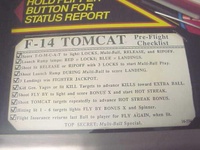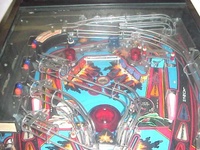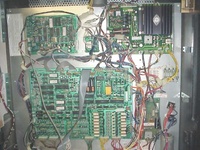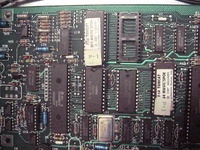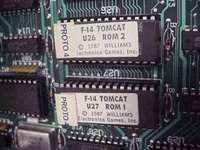
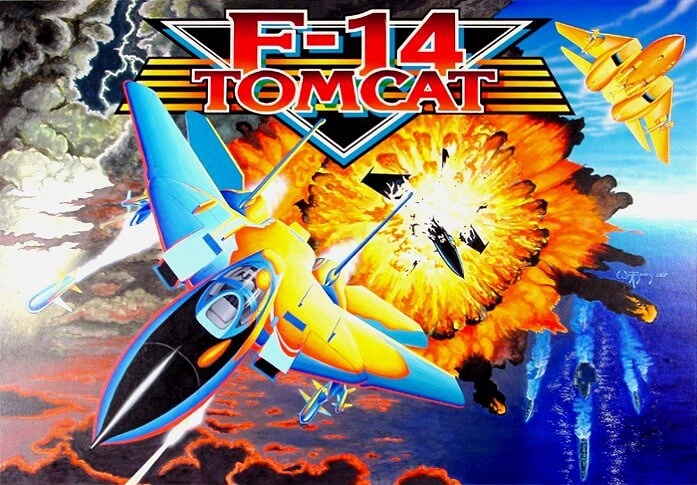
F-14 Tomcat
This game has two 7-digit alphanumeric score displays and two 7-digit numeric-only score displays. Designer Steve Ritchie tells us that there were 10 prototype games made. He also says that, while the X in the serial number means "prototype", this was not used consistently at Williams. One of these games is pictured in this listing with serial number 554-X 94222. The cabinet art design was deemed too plain and was changed for production. The clear flash lamp domes along the back wall of the playfield were too blinding during play, and all were later changed to a red color. The beacons on top of the backbox also were too bright and so their domes were later changed. Included in this listing is a close-up image of a production game having the clear flash lamp domes that were used on the prototypes. This game has the production cabinet artwork. Its backbox beacons look to be the production ones. Reportedly, Early Production models still used the clear domes, but its later serial number of 554 198595 conflicts with that idea. Another later serial number of 554 196508 belongs to a game having prototype MPU ROMs labeled 'PROTO5'. For this reason we have marked as a Prototype Game the two images we have of it. The owner states its sound and speech ROMs have red labels/stickers the same as production ROMs of his other games. It has the clear flash lamp domes at the rear of playfield as well as the clear backbox beacons. Another game pictured here has serial number 554 95836 and has the clear beacons and extra flash lamps like a prototype, but has production cabinet art. The board ROMs are Version 1. The speaker grills have no "W" or any evidence of red paint. The speaker panel itself is attached to the backbox with adhesive instead of being held by an H-shaped support strip. The strip on this game is U-shaped to hold only the backglass above it. Unique to this game is that all the flash lamps have insulation around them. We use the low serial number to classify this example as Early Production. One other such game was discussed on a pinball newsgroup as having the glued speaker panel and the insulated flash lamps, but its speaker grills did have the "W" painted on them. Based on the above examples and their serial numbers, we do not know how to expect which games in the run would be the 10 prototypes of which Steve Ritchie is aware. Because game owners can easily replace their flash domes and beacons with clear versions, this can further the uncertainty. Later playfields in the run had their two flashers disabled and removed because bending targets caused electrical shorts which then damaged the switch matrix. The clear flash domes on these playfields were replaced with red ones. We also note that the playfield layout charts in the manual all depict a third slingshot positioned between the two sets of standup targets at the top of playfield. However, production games do not have this third slingshot. One chart indicated the presence of a 3-inch wireform in apparent conflict with the path of the slingshot kicker (as drawn). According to Steve Ritchie's website, he and his brother Mark Ritchie were the voice talent for this game. Comments from designer Steve Ritchie:F-14 had a first-ever kickback device that fired the ball straight back at the flippers at very high speed, called the Jagov Kicker. F-14 was the first game with "Autosave", which meant the player could have the ball back if it drained prematurely [at the start of a ball], was shot down between the flippers by the Jagov Kicker, or drained during the onset of multiball, etc. We received from a collector in the UK some observations about apparent production run changes. This information has not been confirmed by us: 1) The early games had the audio PCB of the time, '-11298'. This was changed during the run to '-11581' which continued in use until the WPC system came out. 2) There seem to have been three different display PCB's used during the run. The earliest is as used on Millionaire with lamp matrix connections and holes for lamp twist bases but omitting the credit display and its drive components. The second type omitted the unused PCB traces, but remained the same size. These two are larger than the final type, which became the standard used until the 16-digit displays were introduced with Taxi. Production Run Records for F-14 Tomcat: Production Start Date: Mar-23-1987 Production End Date: Jul-17-1987 Production Run Quantity: 14502 First ship date: Mar-24-1987 Last ship date: Nov-2-1987

